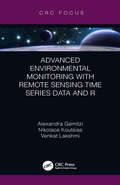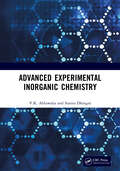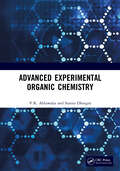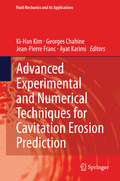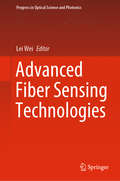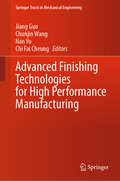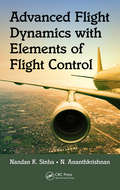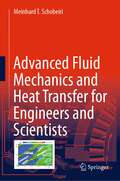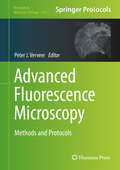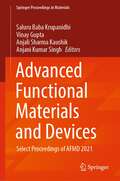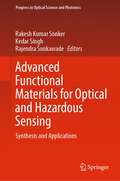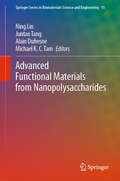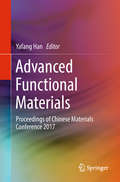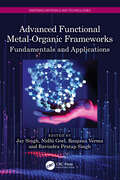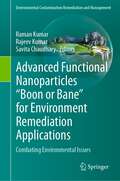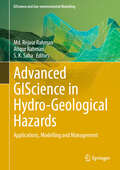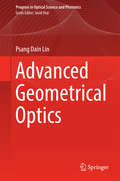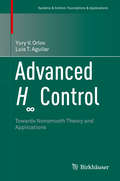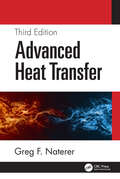- Table View
- List View
Advanced Environmental Monitoring with Remote Sensing Time Series Data and R
by Venkat Lakshmi Alexandra Gemitzi Nikolaos KoutsiasThis book provides a step-by-step guide on how to use various publicly available remotely sensed time series data sources for environmental monitoring and assessment. Readers will learn how to extract valuable information on global changes from a 20-year collection of ready-to-use remotely sensed data through the free open statistical software R and its geographic data analysis and modeling tools. The case studies are from the Mediterranean region—a designated hot spot regarding climate change effects. Each chapter is dedicated to specific remote sensing products chosen for their spatial resolution. The methods used are adapted from large-scale to smaller-scale problems for different land cover areas. Features Includes real-world applications of environmental remotely sensed data Analyzes the advantages and restrictions of each data source Focuses on a wide spectrum of applications, such as hydrology, vegetation changes, land surface temperature, fire detection, and impacts Includes R computer codes with explanatory comments and all applications use only freely available remotely sensed data Presents a step-by-step processing through open source GIS and statistical analysis software Advanced Environmental Monitoring with Remote Sensing Time Series Data and R describes and provides details on recent advances concerning publicly available remotely sensed time series data in environmental monitoring and assessment. This book is a must-have practical guide for environmental researchers, professionals, and students.
Advanced Experimental Inorganic Chemistry
by V.K. Ahluwalia Sunita DhingraThis book is divided into four parts:- Part I deals with Qualitative Inorganic Analysis. Systematic procedures of anion and cation analysis alongwith their confirmatory tests and spot tests are given. Detection of cations by flame photometry and atomic absorption spectroscopy are also incorporated. Besides chromatographic separation and identification of cations are also discussed. - Part II deals with volumetric analysis. The instrumental methods of volumetric analysis have also been incorporated.- Part III deals with gravimetric analysis. Estimation of one or more than one constituent in a solution and instrumental methods of quantitative analysis are also incorporated.- Part IV describes many inorganic preparations. These include simple salts, double salts, complex salts, amalgams, activated metals, organometallics and some other miscellaneous inorganic preparations. The uses of various compounds have also been mentioned.Print edition not for sale in South Asia (India, Sri Lanka, Nepal, Bangladesh, Pakistan or Bhutan)
Advanced Experimental Organic Chemistry
by V.K. Ahluwalia Sunita DhingraAimed at undergraduate and post-graduate students and aligned with the curricula across universities, this book details the fundamental concepts in Organic Chemistry, including – Qualitative analysis of organic compounds: Methods for identifying single compounds and mixtures, with detailed explanations of tests, derivative preparations, and spot tests for functional groups and elements are discussed. Microwave-assisted synthesis is also included. Spectrometric methods: Techniques like IR, UV, NMR, and Mass Spectrometry are explained with practical examples for the analysis of compound structures and applications of these techniques. Practical applications: Chapters on organic compound preparation, natural product isolation, quantitative estimations, and chromatographic techniques for purification are included. The subject matter of this book also includes self-assessment questions for enhanced understanding and practice.Print edition not for sale in South Asia (India, Sri Lanka, Nepal, Bangladesh, Pakistan or Bhutan)
Advanced Experimental and Numerical Techniques for Cavitation Erosion Prediction (Fluid Mechanics and Its Applications #106)
by Ki-Han Kim Georges Chahine Jean-Pierre Franc Ayat KarimiThis book provides a comprehensive treatment of the cavitation erosion phenomenon and state-of-the-art research in the field. It is divided into two parts. Part 1 consists of seven chapters, offering a wide range of computational and experimental approaches to cavitation erosion. It includes a general introduction to cavitation and cavitation erosion a detailed description of facilities and measurement techniques commonly used in cavitation erosion studies, an extensive presentation of various stages of cavitation damage (including incubation and mass loss) and insights into the contribution of computational methods to the analysis of both fluid and material behavior. The proposed approach is based on a detailed description of impact loads generated by collapsing cavitation bubbles and a physical analysis of the material response to these loads. Part 2 is devoted to a selection of nine papers presented at the International Workshop on Advanced Experimental and Numerical Techniques for Cavitation Erosion Prediction (Grenoble, France, 1-2 March 2011) representing the forefront of research on cavitation erosion. Innovative numerical and experimental investigations illustrate the most advanced breakthroughs in cavitation erosion research.
Advanced Fiber Sensing Technologies (Progress in Optical Science and Photonics #9)
by Lei WeiFiber sensing technologies have enabled both fundamental studies and a wide spectrum of applications in every aspect of life. This book highlights the recent advancement in fiber sensing technologies based on newly developed sensing mechanisms, advanced fiber structures, and functional materials. In particular, the integration of functional materials with different electrical, optical, thermal, or mechanical properties into a single fiber offers a wealth of new opportunities in sensing. The book covers the major developments in novel fiber materials, such as semiconductors, metals, polymers, soft glasses, and carbon materials, as well as the sensing applications based on both single fiber and multi-dimensional fiber arrays for temperature, light, strain, vibration, electric and magnetic fields, hazardous chemicals, gases, and physiological signals.
Advanced Finishing Technologies for High Performance Manufacturing (Springer Tracts in Mechanical Engineering)
by Jiang Guo Chunjin Wang Nan Yu Chi Fai CheungThis book comprehensively explores various facets of the polishing field, spanning from traditional techniques to the latest advancements in ultra-precision polishing methods. It provides an updated perspective on the current state of research, covering different ultra-precision polishing technologies, tool applications, process evolution, and future prospects. The content is structured into chapters contributed by subject matter experts worldwide, offering an authoritative overview of recent developments in ultra-precision polishing technology. The book addresses diverse levels of understanding, from foundational concepts to advanced applications. Part I focuses on finishing techniques based on polishing tools, while Part II explores fluid-assisted finishing methods. Part III discusses high-energy beam finishing techniques, and Part IV introduces other emerging finishing approaches. Finally, Part V is dedicated to the applications and developmental trends of ultra-precision polishing technologies. Each part systematically presents a specific polishing technique or application, providing the reader with a step-by-step understanding of this complex and evolving field.
Advanced Fixture Design Method and Its Application
by Guohua QinThis book uses kinematics, mechanics, mathematics, and so on, to systematically propose the fixturing performance evaluation and fixturing layout planning method. The proposed method is a novel method, including the analysis method of locating determination, the analysis method of workpiece stability, the analysis method of clamping reasonability, the analysis method of workpiece attachment/detachment, the analysis method of locating accuracy, and the planning algorithm of locating point layout, the planning algorithm of clamping force, and so forth. It can enrich and develop the basic theory of computer aided fixture design, change the empirical method of fixture design. The combination of theoretical analysis and mathematical modeling technology can resolve the key problems in the process of fixture design, which will play a certain role in promoting the progress of manufacturing technology, improving the precision and level of product manufacturing, and meeting the higher and higher requirements of mechanical manufacturing industry.
Advanced Flight Dynamics with Elements of Flight Control
by Nandan K. Sinha N. AnanthkrishnanAdvanced Flight Dynamics aim to integrate the subjects of aircraft performance, trim and stability/control in a seamless manner. Advanced Flight Dynamics highlights three key and unique viewpoints. Firstly, it follows the revised and corrected aerodynamic modeling presented previously in recent textbook on Elementary Flight Dynamics. Secondly, it uses bifurcation and continuation theory, especially the Extended Bifurcation Analysis (EBA) procedure devised by the authors, to blend the subjects of aircraft performance, trim and stability, and flight control into a unified whole. Thirdly, rather than select one control design tool or another, it uses the generalized Nonlinear Dynamic Inversion (NDI) methodology to illustrate the fundamental principles of flight control. Advanced Flight Dynamics covers all the standard airplane maneuvers, various types of instabilities normally encountered in flight dynamics and illustrates them with real-life airplane data and examples, thus bridging the gap between the teaching of flight dynamics/ control theory in the university and its practice in airplane design bureaus. The expected reader group for this book would ideally be senior undergraduate and graduate students, practicing aerospace/flight simulation engineers/scientists from industry as well as researchers in various organizations. Key Features: Focus on unified nonlinear approach, with nonlinear analysis tools. Provides an up-to-date, corrected, and unified presentation of aircraft trim, stability and control analysis including nonlinear phenomena and closed-loop stability analysis. Contains a computational tool and real-life example carried through the chapters. Includes complementary nonlinear dynamic inversion control approach, with relevant aircraft examples. Fills the gap in the market for a text including non-linear flight dynamics and continuation methods.
Advanced Fluid Mechanics and Heat Transfer for Engineers and Scientists
by Meinhard T. SchobeiriThe current book, Advanced Fluid Mechanics and Heat Transfer is based on author's four decades of industrial and academic research in the area of thermofluid sciences including fluid mechanics, aero-thermodynamics, heat transfer and their applications to engineering systems. Fluid mechanics and heat transfer are inextricably intertwined and both are two integral parts of one physical discipline. No problem from fluid mechanics that requires the calculation of the temperature can be solved using the system of Navier-Stokes and continuity equations only. Conversely, no heat transfer problem can be solved using the energy equation only without using the Navier-Stokes and continuity equations. The fact that there is no book treating this physical discipline as a unified subject in a single book that considers the need of the engineering and physics community, motivated the author to write this book. It is primarily aimed at students of engineering, physics and those practicing professionals who perform aero-thermo-heat transfer design tasks in the industry and would like to deepen their knowledge in this area. The contents of this new book covers the material required in Fluid Mechanics and Heat Transfer Graduate Core Courses in the US universities. It also covers the major parts of the Ph.D-level elective courses Advanced Fluid Mechanics and Heat Transfer that the author has been teaching at Texas A&M University for the past three decades.
Advanced Fluorescence Microscopy: Methods and Protocols (Methods in Molecular Biology #1251)
by Peter J. VerveerThis volume provides an overview of advanced fluorescence microscopy, covering a broad range of methods. Each chapter focuses on a different method and provides a practical guide for application in biological systems. Written in the highly successful Methods in Molecular Biology series format, chapters include introductions to their respective topics, lists of the necessary materials and reagents, step-by-step, readily reproducible laboratory protocols, and tips on troubleshooting and avoiding known pitfalls. Authoritative and cutting-edge, Advanced Fluorescence Microscopy: Methods and Protocols seeks to provide scientists with methods for biological systems that are of interest.
Advanced Fluorescence Reporters in Chemistry and Biology I: Fundamentals and Molecular Design (Springer Series on Fluorescence #8)
by Alexander P. DemchenkoThis volume is focused on one of the most important challenges in sensing and imaging technologies: the design of fluorescence reporters with advanced properties. Here organic dyes occupy leading positions, in tough competition with novel materials such as metal chelating complexes and semiconductor nanoparticles. 11 chapters written by top experts in the field show new possibilities in the design of organic dyes as fluorescent labels and reporters. They particularly highlight the progress that has been made in enhancing the response to intermolecular interactions and their excited-state reaction dynamics (intramolecular charge and proton transfers), and on the development of dyes with strong two-photon absorption and emitting in the near-IR region. Furthermore, fluorophores incorporated into new members of the green fluorescent protein family, an invaluable tool for live cell imaging, are examined.
Advanced Fluorescence Reporters in Chemistry and Biology II: Molecular Constructions, Polymers and Nanoparticles (Springer Series on Fluorescence #9)
by Alexander P. DemchenkoThis volume demonstrates the novel possibilities in sensing and imaging offered by the assembly of organic dyes into nanoparticles and nanocomposites and by the application of strongly fluorescent noble metal clusters and conjugated polymers. Its 14 chapters, written by top experts in this field, provide in-depth information on the coupling of organic dyes to different molecular and supramolecular structures, on their incorporation into polymeric nanoparticles and on the nanostructures that can be formed by some of the dyes. Bright and photostable several-atom clusters of gold and silver are examined. Finally, the revolutionary changes in sensing technologies attending the advent of conjugated polmyers and the advances in their application are discussed.
Advanced Fluorescence Reporters in Chemistry and Biology III: Applications in Sensing and Imaging (Springer Series on Fluorescence #10)
by Alexander P. DemchenkoThe key element of any fluorescence sensing or imaging technology is the fluorescence reporter, which transforms the information on molecular interactions and dynamics into measurable signals of fluorescence emission. This book, written by a team of frontline researchers, demonstrates the broad field of applications of fluorescence reporters, starting from nanoscopic properties of materials, such as self-assembled thin films, polymers and ionic liquids, through biological macromolecules and further to living cell, tissue and body imaging. Basic information on obtaining and interpreting experimental data is presented and recent progress in these practically important areas is highlighted. The book is addressed to a broad interdisciplinary audience.
Advanced Fracture Mechanics and Structural Integrity
by Ashok SaxenaAdvanced Fracture Mechanics and Structural Integrity is organized to cover quantitative descriptions of crack growth and fracture phenomena. The mechanics of fracture are explained, emphasizing elastic-plastic and time-dependent fracture mechanics. Applications are presented, using examples from power generation, aerospace, marine, and chemical industries, with focus on predicting the remaining life of structural components and advanced testing metods for structural materials. Numerous examples and end-of-chapter problems are provided, along with references to encourage further study.The book is written for use in an advanced graduate course on fracture mechanics or structural integrity.
Advanced Functional Materials and Devices: Select Proceedings of AFMD 2021 (Springer Proceedings in Materials #14)
by Saluru Baba Krupanidhi Vinay Gupta Anjali Sharma Kaushik Anjani Kumar SinghThis book presents the select proceedings of the International Conference on Advanced Functional Materials and Devices (AFMD 2021). It highlights the advancements in area of functional materials which includes electronic, magnetic, optical, adaptive and dielectric materials that are required to develop new functionalities with better performance in this new era of technology. The topics covered include materials for energy harvesting, biomedical applications, environmental monitoring, photonics and optoelectronic devices, strategic applications and high energy physics. This book will be a useful reference for beginners, researchers, academicians and professionals working in the area of material science and its allied fields.
Advanced Functional Materials for Optical and Hazardous Sensing: Synthesis and Applications (Progress in Optical Science and Photonics #27)
by Rakesh Kumar Sonker Kedar Singh Rajendra SonkawadeThis book highlights the significance and usefulness of nanomaterials for the development of sensing devices and their real-life applications. The book also addresses various means of synthesizing functional materials, e.g., hydrothermal deposition process, electrospinning, Ostwald ripening, sputtering heterogeneous deposition, liquid-phase preparation, the vapor deposition approach, and aerosol flame synthesis. It presents an informative overview of the role of functional materials in the development of advanced sensor devices at the nanoscale and discusses the applications of functional materials in different forms prepared by diverse techniques in the field of optoelectronics and biomedical devices. Major features, such as type of advanced functional, fabrication methods, applications, tasks, benefits and restrictions, and saleable features, are presented in this book. Advanced functional materials for sensing have much wider applications and have an enormous impact on our environment.
Advanced Functional Materials from Nanopolysaccharides (Springer Series in Biomaterials Science and Engineering #15)
by Alain Dufresne Ning Lin Juntao Tang Michael K. C. TamThis book describes the latest research on nanopolysaccharides in the development of functional materials, from their preparation, properties and functional modifications to the architecture of diverse functional materials. Polysaccharide-based nanoparticles, including nanocellulose, nanochitin, and nanostarch have attracted interest in the field of nanoscience, nanotechnology, and materials science that encompasses various industrial sectors, such as biomedicine, catalyst, coating, energy, optical materials, environmental materials, construction materials, and antibacterial materials. This book establishes a fundamental framework, highlighting the architecture strategies of typical functional systems based on nanopolysaccharides and integrated analysis of their significant influence and properties to various functional behaviors of materials, to help readers to fully understand the fundamental features of nanopolysaccharides and functional materials. Addressing the potential for practical applications, the book also covers the related industrial interests and reports on highly valued products from nanopolysaccharides, providing ideas for future studies in the area. Intended both for academics and professionals who are interested in nanopolysaccharides, it is also a valuable resource for postgraduate students, researchers, and engineers involved in R&D of natural polymers, nanotechnology, and functional materials.
Advanced Functional Materials: Proceedings Of Chinese Materials Conference 2017 (Materials Science Forum Vol. 815 Ser.)
by Yafang HanThis proceedings volume gathers selected papers presented at the Chinese Materials Conference 2017 (CMC2017), held in Yinchuan City, Ningxia, China, on July 06-12, 2017.
Advanced Functional Metal-Organic Frameworks: Fundamentals and Applications (Emerging Materials and Technologies)
by Ravindra Pratap Singh Jay Singh Nidhi Goel Ranjana VermaDue to the structural flexibility, large surface area, tailorable pore size and functional tenability, metal-organic frameworks (MOFs) can lead to materials with unique properties. This book covers the fundamental aspects of MOFs, their synthesis and modification, including their potential applications in different domains. The major focus is on applications including chemical, biosensors, catalysis, drug delivery, supercapacitors, energy storage, magnetics and their future perspectives. The volume: Covers all aspects related to metal-organic frameworks (MOFs), including characterization, modification, applications and associated challenges Illustrates designing and synthetic strategies for MOFs Describes MOFs for gas adsorption, separation and purification, and their role in heterogeneous catalysis Covers sensing of different types of noxious substances in the aqueous environment Includes concepts of molecular magnetism, tunable magnetic properties and future aspects This book is aimed at graduate students, and researchers in material science, coordination and industrial chemistry, chemical and environmental engineering and clean technologies.
Advanced Functional Nanoparticles "Boon or Bane" for Environment Remediation Applications: Combating Environmental Issues (Environmental Contamination Remediation and Management)
by Rajeev Kumar Raman Kumar Savita ChaudharyThis textbook provides an overview of applications of advanced nanomaterials, basic lab set up and requirements in for their synthesis, techniques and career scope of nanotechnology in industries and research. Pollution of air, water, soil is an ever increasing environmental problem attributed to increasing population, global industrialization and unplanned urbanization, has acquired alarming dimensions. It is the most dangerous and worst problem that puts the lives of people, animals, and plants on the earth in danger. An effective, efficient and sustainable approach for managing pollution related problems requires the utmost attention of the scientific community to tackle this menace for the society to lead a healthy and quality life. A number of techniques and books, literatures have been developed in recent years to treat environmental contaminants. However, most of these are not economically viable, environmentally benign and suffer due to cumbersome multi-step manipulations. The purpose of this textbook is to inform students about the application of functionalized nanoparticles as a new approach to supplement traditional treatment methods in cost and time effective manner. The simplistic means to assemble nanoparticles to the constituents of next generation technologies in environment cleanup and sensing are the main objectives of the book. The toxicological footprinting of released advanced functional nanomaterials in ecosystem will also be discussed in the book.
Advanced GIScience in Hydro-Geological Hazards: Applications, Modelling and Management (GIScience and Geo-environmental Modelling)
by Atiqur Rahman Md. Rejaur Rahman S. K. SahaIn recent decades, natural hazards have increasingly threatened lives, livelihoods, and economies, with annual losses totalling billions of dollars globally. According to the Insurance Information Institute (III) and the Zebra, USA, natural disaster losses reached $74.4 billion in 2020, and an average of 6,800 natural disasters occur each year, claiming around 1.35 million lives. Hydrological and geological hazards, in particular, have significant societal and environmental impacts, making them critical areas of research. Understanding and mitigating these hazards is vital for developing legal mechanisms related to environmental restoration, societal improvements, and sustainable development. Modern technologies and earth observation data play a crucial role in disaster monitoring, prediction, modelling, and management. Recent advancements in geoinformation science have introduced multi-source data for natural hazards research. In addition, cutting-edge methods such as machine learning, deep learning, and big data science offer powerful tools for in-depth studies of natural hazards through remote sensing and geoinformatics. This book, Advanced GIScience in Hydro-Geological Hazards, presents up-to-date contributions on applying advanced GIScience to research various hydro-geological hazards, including floods, landslides, tropical cyclones, soil erosion, coastal erosion, riverbank erosion, coastal area vulnerability, drought, wetlands shrinking etc. It also explores multi-hazard studies using SAR, GNSS, and other innovative methods. The chapters focus on integrating artificial intelligence, machine learning techniques, and remote sensing to enhance preparedness, response, and resilience against these hazards. Targeting a broad audience of academics, scientists, students, environmentalists, government agencies, disaster planners, and GIS experts, this book aims to showcase the latest advancements in GIScience for assessing and managing hydro-geological hazards. It offers strategies for disaster risk reduction and capacity building, providing readers with the knowledge needed to address pressing environmental challenges.
Advanced Geometrical Optics (Progress in Optical Science and Photonics #4)
by Psang Dain LinThis book computes the first- and second-order derivative matrices of skew ray and optical path length, while also providing an important mathematical tool for automatic optical design. This book consists of three parts. Part One reviews the basic theories of skew-ray tracing, paraxial optics and primary aberrations - essential reading that lays the foundation for the modeling work presented in the rest of this book. Part Two derives the Jacobian matrices of a ray and its optical path length. Although this issue is also addressed in other publications, they generally fail to consider all of the variables of a non-axially symmetrical system. The modeling work thus provides a more robust framework for the analysis and design of non-axially symmetrical systems such as prisms and head-up displays. Lastly, Part Three proposes a computational scheme for deriving the Hessian matrices of a ray and its optical path length, offering an effective means of determining an appropriate search direction when tuning the system variables in the system design process.
Advanced H Control: Towards Nonsmooth Theory and Applications (Systems & Control: Foundations & Applications)
by Luis T. Aguilar Yury V. OrlovThis compact monograph is focused on disturbance attenuation in nonsmooth dynamic systems, developing an H∞ approach in the nonsmooth setting. Similar to the standard nonlinear H∞ approach, the proposed nonsmooth design guarantees both the internal asymptotic stability of a nominal closed-loop system and the dissipativity inequality, which states that the size of an error signal is uniformly bounded with respect to the worst-case size of an external disturbance signal. This guarantee is achieved by constructing an energy or storage function that satisfies the dissipativity inequality and is then utilized as a Lyapunov function to ensure the internal stability requirements. Advanced H∞ Control is unique in the literature for its treatment of disturbance attenuation in nonsmooth systems. It synthesizes various tools, including Hamilton-Jacobi-Isaacs partial differential inequalities as well as Linear Matrix Inequalities. Along with the finite-dimensional treatment, the synthesis is extended to infinite-dimensional setting, involving time-delay and distributed parameter systems. To help illustrate this synthesis, the book focuses on electromechanical applications with nonsmooth phenomena caused by dry friction, backlash, and sampled-data measurements. Special attention is devoted to implementation issues. Requiring familiarity with nonlinear systems theory, this book will be accessible to g raduate students interested in systems analysis and design, and is a welcome addition to the literature for researchers and practitioners in these areas.
Advanced Heat Transfer
by Greg F. NatererThe book provides a valuable source of technical content for the prediction and analysis of advanced heat transfer problems, including conduction, convection, radiation, phase change, and chemically reactive modes of heat transfer. With more than 20 new sections, case studies, and examples, the Third Edition broadens the scope of thermal engineering applications, including but not limited to biomedical, micro- and nanotechnology, and machine learning. The book features a chapter devoted to each mode of multiphase heat transfer. FEATURES Covers the analysis and design of advanced thermal engineering systems Presents solution methods that can be applied to complex systems such as semi-analytical, machine learning, and numerical methods Includes a chapter devoted to each mode of multiphase heat transfer, including boiling, condensation, solidification, and melting Explains processes and governing equations of multiphase flows with droplets and particles Applies entropy and the second law of thermodynamics for the design and optimization of thermal engineering systems Advanced Heat Transfer, Third Edition, offers a comprehensive source for single and multiphase systems of heat transfer for senior undergraduate and graduate students taking courses in advanced heat transfer, multiphase fluid mechanics, and advanced thermodynamics. A solutions manual is provided to adopting instructors.
Advanced High School Statistics
by David DiezThe OpenIntro project was founded in 2009 to improve the quality and availability of education by producing exceptional books and teaching tools that are free to use and easy to modify. We feature real data whenever possible, and files for the entire textbook are freely available at openintro.org. The future for OpenIntro depends on the involvement and enthusiasm of our community. Visit our website, openintro.org. We provide free videos, statistical software labs, lecture slides, course management tools, and many other helpful resources. This textbook is also available for $20. However, we offer this $25 retail price version to hit the minimum for free shipping on some platforms.
